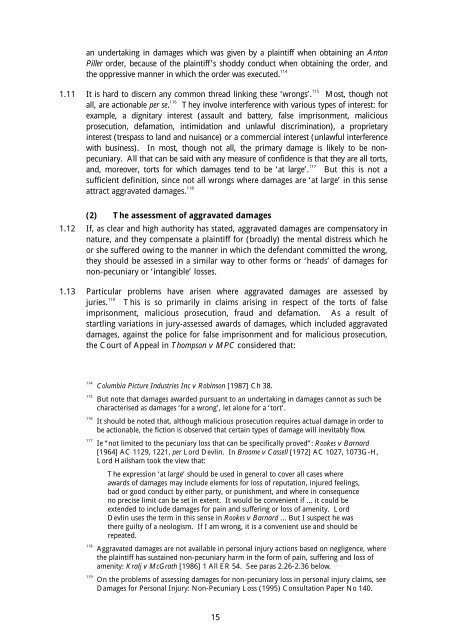Aggravated, Exemplary and Restitutionary ... - Law Commission
Aggravated, Exemplary and Restitutionary ... - Law Commission
Aggravated, Exemplary and Restitutionary ... - Law Commission
Create successful ePaper yourself
Turn your PDF publications into a flip-book with our unique Google optimized e-Paper software.
an undertaking in damages which was given by a plaintiff when obtaining an Anton<br />
Piller order, because of the plaintiff’s shoddy conduct when obtaining the order, <strong>and</strong><br />
the oppressive manner in which the order was executed. 114<br />
1.11 It is hard to discern any common thread linking these ‘wrongs’. 115<br />
Most, though not<br />
all, are actionable per se. 116<br />
They involve interference with various types of interest: for<br />
example, a dignitary interest (assault <strong>and</strong> battery, false imprisonment, malicious<br />
prosecution, defamation, intimidation <strong>and</strong> unlawful discrimination), a proprietary<br />
interest (trespass to l<strong>and</strong> <strong>and</strong> nuisance) or a commercial interest (unlawful interference<br />
with business). In most, though not all, the primary damage is likely to be nonpecuniary.<br />
All that can be said with any measure of confidence is that they are all torts,<br />
<strong>and</strong>, moreover, torts for which damages tend to be ‘at large’. 117<br />
But this is not a<br />
sufficient definition, since not all wrongs where damages are ‘at large’ in this sense<br />
attract aggravated damages. 118<br />
(2) The assessment of aggravated damages<br />
1.12 If, as clear <strong>and</strong> high authority has stated, aggravated damages are compensatory in<br />
nature, <strong>and</strong> they compensate a plaintiff for (broadly) the mental distress which he<br />
or she suffered owing to the manner in which the defendant committed the wrong,<br />
they should be assessed in a similar way to other forms or ‘heads’ of damages for<br />
non-pecuniary or ‘intangible’ losses.<br />
1.13 Particular problems have arisen where aggravated damages are assessed by<br />
juries. 119<br />
This is so primarily in claims arising in respect of the torts of false<br />
imprisonment, malicious prosecution, fraud <strong>and</strong> defamation. As a result of<br />
startling variations in jury-assessed awards of damages, which included aggravated<br />
damages, against the police for false imprisonment <strong>and</strong> for malicious prosecution,<br />
the Court of Appeal in Thompson v MPC considered that:<br />
114 Columbia Picture Industries Inc v Robinson [1987] Ch 38.<br />
115 But note that damages awarded pursuant to an undertaking in damages cannot as such be<br />
characterised as damages ‘for a wrong’, let alone for a ‘tort’.<br />
116 It should be noted that, although malicious prosecution requires actual damage in order to<br />
be actionable, the fiction is observed that certain types of damage will inevitably flow.<br />
117 Ie “not limited to the pecuniary loss that can be specifically proved”: Rookes v Barnard<br />
[1964] AC 1129, 1221, per Lord Devlin. In Broome v Cassell [1972] AC 1027, 1073G-H,<br />
Lord Hailsham took the view that:<br />
The expression ‘at large’ should be used in general to cover all cases where<br />
awards of damages may include elements for loss of reputation, injured feelings,<br />
bad or good conduct by either party, or punishment, <strong>and</strong> where in consequence<br />
no precise limit can be set in extent. It would be convenient if ... it could be<br />
extended to include damages for pain <strong>and</strong> suffering or loss of amenity. Lord<br />
Devlin uses the term in this sense in Rookes v Barnard ... But I suspect he was<br />
there guilty of a neologism. If I am wrong, it is a convenient use <strong>and</strong> should be<br />
repeated.<br />
118 <strong>Aggravated</strong> damages are not available in personal injury actions based on negligence, where<br />
the plaintiff has sustained non-pecuniary harm in the form of pain, suffering <strong>and</strong> loss of<br />
amenity: Kralj v McGrath [1986] 1 All ER 54. See paras 2.26-2.36 below.<br />
119 On the problems of assessing damages for non-pecuniary loss in personal injury claims, see<br />
Damages for Personal Injury: Non-Pecuniary Loss (1995) Consultation Paper No 140.<br />
15
















